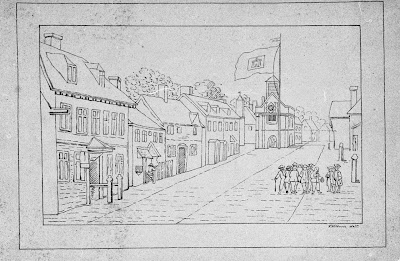We can say with absolute certainty that sailors in the nineteenth century tarred their hats and, at times, other garments as a way to prevent water from weighing them down or soaking through to their skin. I was lucky enough to examine some nineteenth century tarred hats in Mystic Seaport's collection, including the one worn by Richard Henry Dana during his service on which Two Years Before the Mast was written.
But what about the eighteenth century?
There are precious few written primary sources on the dress of eighteenth century sailors, and of those that exist, I have not yet found any that describe the tarring of hats.
However, the 1785 wreck of the General Carleton off Poland, excavated several times during the 1990's, has revealed the only known example of an eighteenth century tarred hat. An excellent color photo of the same can be found in this presentation of men's headwear by the 18th Century Material Culture Resource Center (page 60). At that, while searching for tarred clothing, I did come across a reference in the Description of the Western Isles of Scotland and the Hybrides written in 1777. In relating the robbery of Jack Tars by highwaymen, the author relates that the sailors gave up their "tarpawlin breeches."
It is also quite possible that there were other means of weatherproofing. Again I turn to the 18th Century Material Culture Resource Center (this time on page 56) for the hat of Captain Samuel Dunn. It's a jacked leather hat, and though I'm certainly no expert on the treating of leather, I am curious as to whether or not the process of jacking leather would provide some protection against the weather. I encourage any response that can help with that!
 |
| From gaspee.org |
Perhaps the common assertion that the common nicknames of sailors ("Jack Tar" or "Tarpawlin") is a direct reference to their tarred clothing is true, but I have yet to find any direct proof of that. Working on a ship would naturally coat sailors in tar simply by happenstance, rather than by a direct effort to weatherproof. We should also remember that every source I've referenced here is 1770's and later. Could that simply be because the closer we get to our own time, the more likely that an artifact or textual source would survive? Or is it because this form of weatherproofing simply wasn't employed before then?
What are your thoughts?









.jpg)

.jpg)


